Knowing how to cool down a dog is important if you plan to play outside with your pup in the summer heat. Integrative veterinarian Dr. Julie Buzby provides 10 cool ideas to help you help your dog cool down again once he or she is overheated.
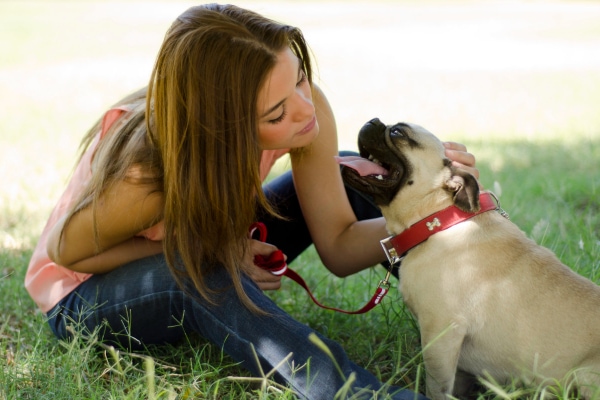
During the hot summer months, it is wonderful to be outside playing with your dog. There are so many activities you and your dog can enjoy while getting some Vitamin D and exercise.
However, on hot days, it can be hard to find ways for you and your dog to beat the heat while still having fun together outside. If your dog starts to get too hot, it is important to know how to quickly cool your dog down before he or she overheats. Otherwise, your pup could develop heat stroke—which can be deadly.
Let’s take a quick look at heat stroke (and its precursor, heat exhaustion) so you know what to watch for. Then, we will discuss how to cool down a dog using 10 methods, so you can hopefully help avoid the dangers the heat can pose for your dog.
- Heat stroke and heat exhaustion 101
- How to cool down a dog
- #1: Offer drinking water
- #2: Escape the heat
- #3: Relax and take a break from playing
- #4: Chill on a cooling mat
- #5: Apply an icepack to your dog's body
- #6: Avoid using towels
- #7: Go for a swim
- #8: Use the garden hose
- #9. Don't shave your dog's fur
- #10: Don't let your dog shiver
- Monitor your dog closely (especially high-risk dogs)
- When in doubt, call the vet
- Keep your dog safe and cool
- What is your dog's favorite way to cool down in the summer?
Heat stroke and heat exhaustion 101
As the names would imply, heat stroke and heat exhaustion both happen when the summer heat (or heat at other times of the year) and/or the dog’s activity level at that temperature overwhelms the body’s normal cooling mechanisms.
A dog’s body has several built-in methods to cool down. They include:
- Panting
- Sweating through the dog’s paws
- Expansion of blood vessels (i.e. vasodilation) in the face, ears, and skin to increase blood flow to those areas and therefore dissipate heat
- Lying on a cool surface to transfer heat from the body to the surface
Of these mechanisms, panting and lying on something cool are the primary ways dogs cool themselves off.
Heat exhaustion often comes first
As the dog’s body begins to heat up, it will eventually reach a tipping point where it can no longer cool off enough to maintain the body temperature in a safe range. If the dog continues to exercise or remains in a hot environment (a hot car, the yard with no shade, etc.), heat exhaustion sets in.
You may notice that your dog starts panting heavily. His or her tongue is probably huge and lolling far out of the mouth. And he or she seems unable to stop panting. Plus, dogs with heat exhaustion may become weak or flop on the ground and be unwilling (or unable) to get back up again. Sometimes they may also seem dazed or a bit dizzy.
Then heat stroke sets in
This point—or ideally before this point—is the time to intervene and take steps to cool down your dog. Otherwise, heat exhaustion could progress into heat stroke, which is potentially fatal.
Signs of heat stroke in dogs include those of heat exhaustion plus:
- Seizures in dogs
- Altered mental state (confused, disoriented, etc.)
- Vomiting or diarrhea (sometimes containing blood)
- Spontaneous bruising or bleeding
- Incoordination
- Stupor or loss of consciousness
- Reddish, brownish, or pale gums
- Elevated body temperature (over 105°F, but often 107-109°F)
If you see any of these signs of heat stroke, or you are unsure if your dog has heat stroke or heat exhaustion, stop reading now. Quickly mist your dog with cool (not cold) water, put him or her in the car with the air conditioning blasting, and start driving to the vet for an emergency vet visit ASAP.
Heat stroke can lead to organ failure, disseminated intravascular coagulation (DIC), and death. Time is of the essence when it comes to getting help for your dog.
How to cool down a dog
On the other hand, if you think your dog is overheating but he or she isn’t showing any signs of heat stroke or severe heat exhaustion, it is usually safe to try to cool him or her off at home. (But see the end of the article to learn which dogs this may not be the case for.) The 10 methods I’m about to discuss can help you help your dog cool down quickly and safely in the hot summer weather.
#1: Offer drinking water
When you have been outside mowing the grass, pulling weeds, or walking, what is the first thing you do when you are hot and sweaty? You take a drink of nice, cold water. This is because it feels good, rehydrates you, and has immediate cooling effects. The same is true for your dog (or other animals).
Encouraging your dog to drink water is a great way to help him or her cool off and prevent dehydration. This is doubly helpful because staying properly hydrated is also one of the best ways to help keep your dog cool in the summer.
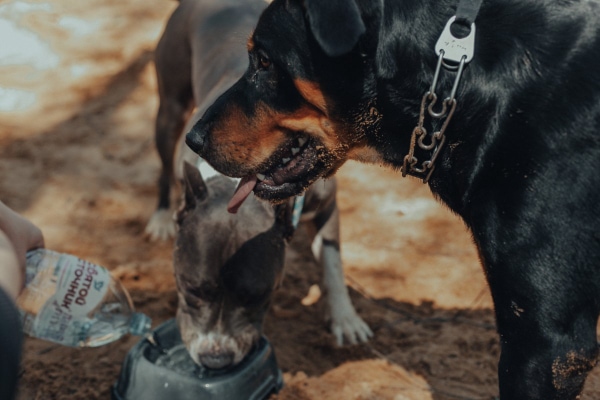
Whenever you offer your dog drinking water, it is important to make sure it is clean and fresh. Dogs are less likely to drink unclean water. So if the water in your dog’s bowl appears dirty or contaminated, empty it out and clean the bowl. Then refill the bowl with fresh water. This is a simple, but very important, way to keep your dog hydrated.
If you are out hiking or camping, consider carrying a water bottle for your dog as well as yourself. Also, ensure your dog doesn’t drink (or swim in) water that contains blue-green algae. Unfortunately, blue-green algae and dogs are a deadly combination.
I also want to caution you against giving your dog a large amount of ice water. While unlikely, the resulting rapid change in body temperature (going from hot to cold) could theoretically shock your dog’s system. And occasionally this can worsen your dog’s condition.
#2: Escape the heat
Drinking cool water can definitely help significantly. But ultimately, getting out of the heat is the most important way to cool dogs down in hot weather. If your dog is already overheated and he or she stays in the same hot environment, the internal body temperature will continue to rise. This is usually the case no matter how many other things you do to cool him or her off.
Head to the car or RV
If you are out hiking or camping, getting to a cooler place can be a bit challenging. Ideally, you would bring your dog to a car, RV, or other location with working air conditioning. If that isn’t an option, move into the shade and offer your dog some water. And then find a cooler place as soon as possible.
Find a cool room in the house
If you are at home, bring your dog inside. Let him or her relax in the coolest room of the house with good airflow. And try to keep your dog from laying in front of a window or door where there might be direct sunlight coming in. Even inside, the sunlight could cause your dog’s temperature to rise.
If you have air conditioning, turn it on (or turn it to a cooler setting) for a while to help your dog cool down. Letting the air conditioner blast probably feels every bit as good to your furry friend as it does to you when you are overheated.
Use a fan
I know that not everyone has AC, though. In that case, sometimes fans can help dogs cool off. But other times they just circulate hot air, which may not make much difference.
Before trying to cool your dog down with a fan, you may want to stand in front of it and see if it makes you feel cooler. If so, see if your dog wants to lay near it. But ensure you place the fan in a way that your dog can move away from the direct airflow if he or she wants to.
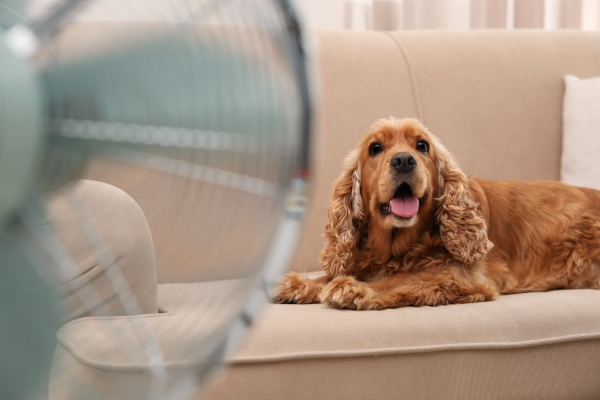
#3: Relax and take a break from playing
While inside the house (or other location to escape the heat), it is very important to keep your dog calm. If your dog is running, playing, or jumping, he or she will keep raising the internal body temperature. As a result, your dog may continue to overheat. And then he or she might progress to heat exhaustion or heat stroke.
If your dog is still very excited and wants to play, but you know he or she is hot, encourage your dog to lie down with you on the couch or on the floor. Sometimes, I will even put my dog on a leash and sit down with his favorite safe chewing toy for dogs. Or I might give him a frozen Kong or another cold treat. This encourages him to stay with me and lay down rather than trying to play fetch or be crazy.
Additionally, you should avoid going back outside in the heat for a while. If you believe your dog started to overheat, I recommend staying out of the heat and relaxing for at least one to two hours.
However, if your dog actually did overheat or started to show signs of heat exhaustion, it is important to keep him or her inside a cool environment for at least 24 hours. This gives your dog some time to recover from the heat stress. During these 24 hours, it is okay for your dog to move around and take quick trips outside to potty. But he or she should be kept calm and cool as much as possible.
#4: Chill on a cooling mat
While relaxing and cooling down, your dog will probably look for a cool place to lie down. Often, dogs will seek out the hard floor (e.g., tile or wood floors). This makes sense because those surfaces are cooler than carpet or dog beds. But the hard floor can be uncomfortable to lie on for a long time (especially for senior dogs or those with osteoarthritis in dogs).
Additionally, dogs who have trouble walking on slippery floors may be afraid to lie down on them for fear of not being able to get back up again. (If this is your dog, check out my signature product Dr. Buzby’s ToeGrips® dog nail grips. They can help dogs regain their grip and confidence on slippery floors.)
For the reasons we just discussed, cooling mats for dogs are a much better alternative to lying on a hard floor. They are a good idea because they are effective at helping a dog cool down. And they are much more comfortable for a dog to lay on than the hard floor.
Cooling mats also can feel relaxing to dogs—especially the ones with continuous water movement, which feels like a massage. And as an added benefit, cooling mats can encourage your dog to relax in one place instead of running around.
#5: Apply an icepack to your dog’s body
If after trying these things, your dog still appears hot or overheated, using an ice pack might help. Ice packs are a great way to provide additional cooling power. But they usually are not effective by themselves.
Should you decide to try an ice pack, please wrap it in a thin towel or cloth before applying it to your dog’s skin. Dogs can develop “cold burns” just like people. So it is important to always provide a protective layer between the pack and the skin when using an ice (or heat) pack.
When using an ice pack, the most effective places to put it are your dog’s:
- Armpits
- Neck
- Groin (the areas inside the inner thigh and against the belly)
These three locations often have less hair and higher concentrations of large surface blood vessels. Both characteristics allow the dog’s body to release heat and/ or transfer it to the icepack quickly.
I want to offer a word of caution, though. Don’t use ice packs for longer than 15-20 minutes at a time (especially in one location). Otherwise, the ice pack could cause a cold burn (even with a towel wrapped around it).
I usually recommend using an ice pack in three 5-minute increments. At each 5-minute mark, lift the ice pack and check your dog’s skin for redness or irritation. If your dog appears to be tolerating the ice pack well, you can proceed with the next increment until you have completed the full 15-20 minutes.
Also, keep an eye on your dog’s attitude. If your dog appears uncomfortable or stressed, do not force him or her to lie with the ice pack. Causing stress while trying to use the ice pack will just increase the internal body temperature.
One ice pack = yes. But ICE BATHS = NO.
As a final word of caution, applying one ice pack to one part of the body is usually safe because it just affects the vessels in a small area. But ice baths (or, to a lesser extent, using multiple ice packs) are a big “NO.”
Putting your overheated dog or one with heat stroke or heat exhaustion into an ice bath or cold water is dangerous.
Whole-body extreme cooling can cause the vessels in the skin to constrict, trapping all the hot blood in the center of the dog’s body. This can put extra stress on the heart and other internal organs.
#6: Avoid using towels
In addition to ice packs, I often have clients ask about using wet towels to cool off their dog. I understand why many clients want to use them. However, in most scenarios, wet towels are more harmful than helpful when it comes to cooling down your dog.
Wet towels do help get dogs wet without hosing them down or putting them in the bathtub. But, towels (especially when wet) are not very breathable and don’t allow for good airflow. As the towel clings to your dog or begins to dry, it can actually trap heat inside. This may prevent your dog from releasing his or her internal heat.
Instead of using a wet towel, use a cooling mat or ice pack as described above. Or take your dog swimming or do some water playtime.
#7: Go for a swim
Another common question I get is if swimming cools dogs off or not. As it turns out, swimming is a great way to cool your dog off. It probably feels wonderful to dogs who are hot from being outside or sitting in the house without air conditioning. Plus, swimming is a fun and enjoyable way for you to play with your dog while cooling down. Whether your dog is swimming in a deeper lake or wading through a kiddie pool, the water can be very refreshing.
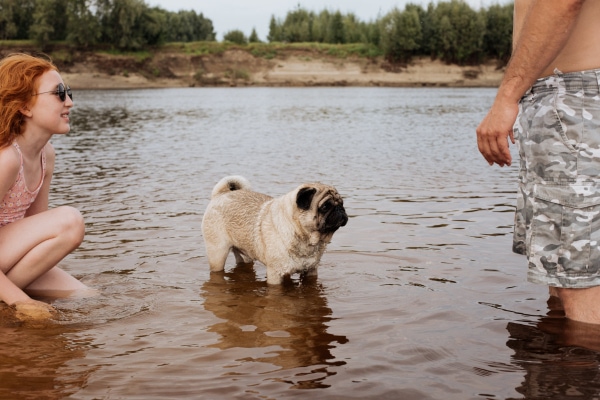
However, if your dog has started overheating and is approaching heat exhaustion territory, swimming might not be the best way to cool down. The water is cool. But your dog’s body temperature can still rise from the hot environmental temperature and the constant exposure to the sun.
Additionally, swimming takes energy. This can increase your dog’s blood flow and raise his or her temperature. And if your dog is swimming in salt water and drinks it, that also can cause dehydration. In turn, dehydration increases the risk of heat exhaustion or heat stroke.
In summary, if your dog is hot and panting because it is warm outside, going for a swim is a great way for him or her to cool down. But, if your dog appears to be overheating, it is best to use a different method to cool down.
#8: Use the garden hose
However, not everyone enjoys swimming or has the option to go swimming. My clients often ask about hosing down a dog to help cool them off. My answer to this is very similar to swimming.
Getting dogs wet with a hose or letting them play in water does help them cool down when it is hot outside. But, if your dog is already overheating, playing with a hose is not the best way to cool him or her down for the same reasons we discussed in the swimming section. Use your best judgment when deciding whether to use a hose, sprinkler, or a mister to cool off your dog.
As a word of caution, sometimes the residual water in the hose can be hot enough to burn your dog. (To learn more, check out this article on garden hose scalding syndrome in dogs.) Therefore, it is safest to let the water run for a minute or two and/or check the water temperature before spraying it on your dog or letting him or her play in it.
#9. Don’t shave your dog’s fur
When noticing their dog is hot, I sometimes hear dog parents say they want to shave their dog to help him or her cool down faster. This is not a good idea for a few reasons:
- Shaving is not a fast process. If your dog needs to cool down quickly, shaving the fur will take much longer than other cooling methods.
- Some dogs are very stressed during haircuts or shaving. If this is the case, stress will increase a dog’s body temperature.
- Most importantly, shaving does not help cool down most dogs. In fact, dogs who have double-layer coats (like Huskies, German Shepherds, and Labrador Retrievers) actually use their fur as a cooling mechanism. And it helps them regulate their internal body temperature. So shaving them makes it harder for them to stay cool.
- If you shave dogs with a double-layer coat, the fur may never grow back properly. This prevents the coat from protecting your dog from heat, cold, stickers and bushes, and more.
If you need to cool your dog down, one of the first eight options described above will be much more effective.
#10: Don’t let your dog shiver
Once you start cooling down your dog with any of the methods above, it is very important to not let your dog shiver. If your dog starts shivering or shaking, stop whatever you are doing to cool him or her off.
Shivering is a problem for two reasons. First, the shaking actually takes more energy and causes a dog’s body temperature to rise. This could send an overheated dog over the edge. Second, shivering and shaking can be a sign that your dog’s body temperature has changed too much too quickly. In this situation, your dog could possibly go into shock.
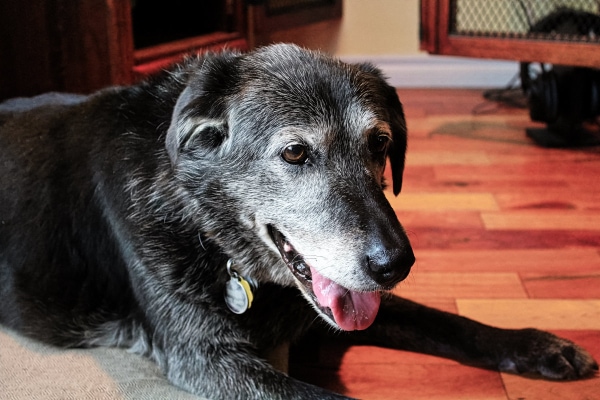
Therefore, if your dog starts shivering, stop the cooling, but don’t try to warm your dog up. Switching to active warming could cause your dog to overshoot a “normal” temperature. This yo-yo effect between “too hot” and “too cold” is not good for your dog’s body.
Instead of trying to alter your dog’s temperature, monitor him or her closely. And if the shaking doesn’t resolve quickly or you have any concerns about how your dog is doing, please consult your veterinarian promptly. It is always better to make a vet visit for reassurance than it is to regret not going in soon enough. Trust your dog’s parent’s intuition!
Monitor your dog closely (especially high-risk dogs)
The tips I just shared to help cool down your dog can be effective for many dogs. But I want to make it clear that if you believe your dog has started to overheat, it is extremely important that you monitor him or her closely. Overheating can quickly progress to heat exhaustion, which then can become heat stroke. Heat stroke is very dangerous and can be fatal to dogs.
Vigilant monitoring is especially important for dogs who are at increased risk of overheating. Some examples include:
- Overweight dogs—A higher body condition score (BCS) in dogs makes them more likely to have a difficult time breathing and exercising without becoming overwhelmed. This increases their risk of developing heat exhaustion.
- Senior dogs—Older dogs are more likely to have concurrent diseases which affect their ability to dissipate heat. And they tend to tire faster. This may not leave them with enough energy to get to a cool place or walk over to the water bowl.
- Brachycephalic dogs— Flat-faced dogs like Pugs or Bulldogs have smaller nasal openings and smaller nasal passages. This makes it difficult for them to breathe well and regulate their body temperature, especially in hot or humid weather.
- Dogs with dark or black coats— Dark colors trap heat, making it harder for your dog to stay cool.
- Cardiac or respiratory conditions—Dogs with collapsed trachea in dogs, heart disease in dogs, or other similar problems have a lower ability to tolerate heat.
However, remember that just because your dog isn’t on this list, doesn’t mean he or she is safe from the dangers of heat exhaustion and heat stroke. Any dog of any breed, age, or sex can develop, or die from, heat-related illnesses.
When in doubt, call the vet
If your dog falls into one of the increased risk categories and you think he or she may be too warm, I recommend consulting your veterinarian right away. These dogs can quickly move from being overheated to showing signs of severe heat exhaustion or heat stroke.
For “lower risk” dogs who just appear to be hot, it may be okay to monitor them and try to cool them down at home. But you should call your vet if you have any concerns about how your dog is acting or looking. Overheating has the potential to have dangerous consequences for all dogs.
In either situation, your vet might tell you to monitor at home and try one of the cooling methods that were discussed in this article. Or he or she may recommend a trip to the veterinary clinic or emergency hospital.
If the vet recommends cooling and monitoring at home, keep an eye on your dog for weakness, disorientation, GI signs, or any of the other symptoms of heat exhaustion or heat stroke. If you know how to take a dog’s temperature, you can also check it every 15-30 minutes to track how your dog is cooling down.
Should you become worried about your dog’s condition at any point in the process, please call your veterinarian right away and take your dog to the nearest vet hospital. Heat-related illnesses are nothing to mess around with!
Keep your dog safe and cool
I know that the last sections of the article may have been a bit heavy. My intent isn’t to spoil your summer fun, just to help you help your dog stay safe. The good news is that while overheating can become an emergency, most dogs and their owners will be able to enjoy the hot summer days safely and create long-lasting memories.
By using the 10 tips in this article to cool down your dog, you and your pup can have fun in the sun and cool down together. I hope you have a safe and cool summer!
What is your dog’s favorite way to cool down in the summer?
Please comment below.


Thank u for the information.
Hi Hilda,
I am glad the article was helpful. Best wishes!
I have a small pool for my dog and I spray her down with hose. She is a dark lab outside dog.
Hi Jeff,
I am sure your Lab is enjoying her time in the pool. She is a lucky pup to have you coming up with such great ways to keep her comfortable during the hot summer months. Thank you for sharing and keep up the good work!
I’m taking care of my brother’s 2 pit bulls the heat is unbearable. the have no AC to stay cool inside. they have to stay outside. we’re they lay the coolest in the yard is all sand and the fleas are unbearable. I’ve sprayed 3 to 4 times and the fleas seem to get worse. and then the heat there so miserable.. I’ve been letting them cool off in my car when I have the gas. I have other dogs at home I have to take care of also. I can’t get no help. what if anything can I cover the dirt that they will lay on to stay cool. I don’t have alot of options I need some advice. please
Hi Kathryn,
I am so sorry you are in this difficult situation with your brother’s dogs. Thank you for trying to help them and being concerned for their well-being. A kiddie pool or other way to allow them to get into water would be best. Honestly, their living condition has me concerned and it may be time to think about rehoming these pups. Their welfare is of utmost importance and needs to be addressed right away. Please reach out to your local humane society or shelter and see if they have any funds or programs that would be able to offer assistance. Praying you can find the help you need to restore their quality of life. Bless you and best wishes. ♥